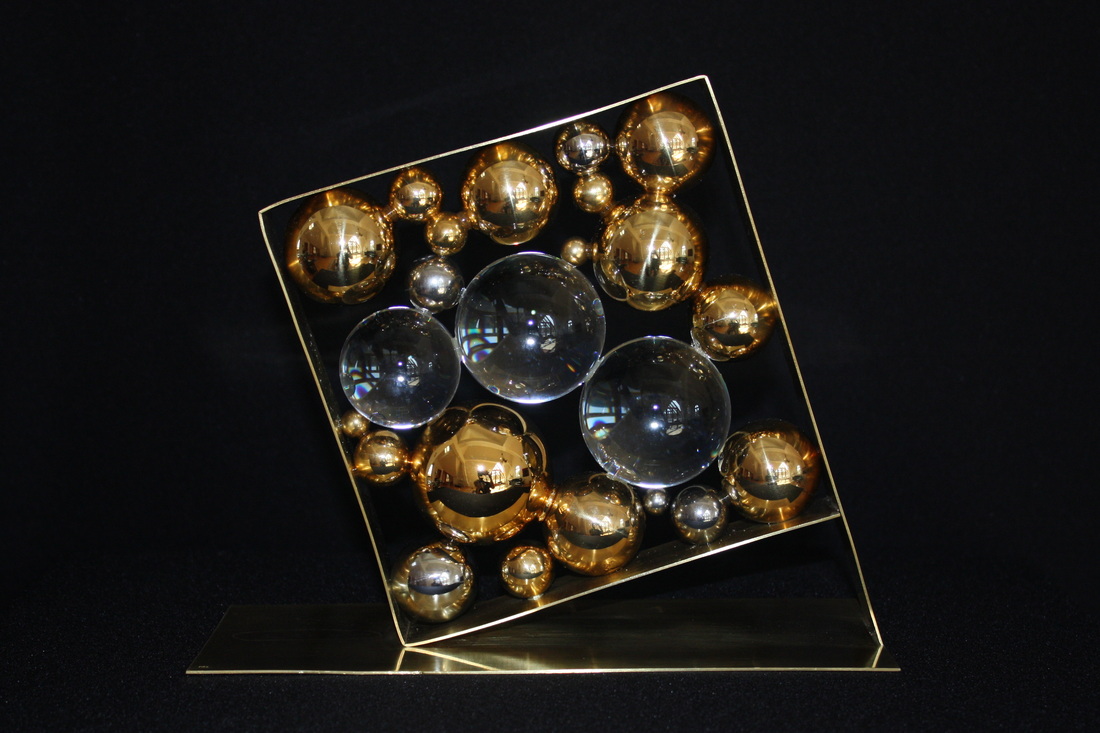The "Wow Signal"
In Ohio, on August 15, 1977 the "Big Ear", the radio telescope of the Ohio State University Radio Observatory was pointed toward the constellation Sagittarius.
Suddenly, the "Big Ear" received a strong narrowband radio signal, which lasted for 72 seconds. It did draw the attention of the astronomer working then on the SETI project of NASA.
SETI stands for "Search for Extraterrestrial Intelligence".
Amazed at how closely the signal matched the expected signature of an interstellar signal, the astronomer J.Ehman circled the signal "6EQUJ5" on the computer printout and added the comment "wow".
This comment became the name of the signal.
This metal artwork is the result of my attempt to turn the "Wow Signal" into a shape.
In Ohio, on August 15, 1977 the "Big Ear", the radio telescope of the Ohio State University Radio Observatory was pointed toward the constellation Sagittarius.
Suddenly, the "Big Ear" received a strong narrowband radio signal, which lasted for 72 seconds. It did draw the attention of the astronomer working then on the SETI project of NASA.
SETI stands for "Search for Extraterrestrial Intelligence".
Amazed at how closely the signal matched the expected signature of an interstellar signal, the astronomer J.Ehman circled the signal "6EQUJ5" on the computer printout and added the comment "wow".
This comment became the name of the signal.
This metal artwork is the result of my attempt to turn the "Wow Signal" into a shape.
Le signal "Wow"
A Ohio, le 15 août 1977, le radiotélescope d'Ohio State University Radio Observatory "The Big Ear" était dirigé vers la constellation du Sagittaire.
Soudain, "la grande oreille" capta un signal radio à bande étroite d'une durée de 72 secondes. L'astrophysicien en charge du projet SETI de la NASA ne manqua pas de remarquer ce fait.
SETI "Search for Extraterrestrial Intelligence" peut se traduire par "Recherche d'une intelligence extraterrestre".
Stupéfié par l'intensité du signal, qui correspondait à la signature attendue d'un signal interstellaire, l'astrophysicien J. Ehman entoura au stylo le signal "6EQUJ5" sur la sortie imprimée de l'ordinateur et écrivit le commentaire "wow".
Ce commentaire est devenu le nom du signal.
Cet objet d'art est ma tentative de donner une forme au signal " wow".
A Ohio, le 15 août 1977, le radiotélescope d'Ohio State University Radio Observatory "The Big Ear" était dirigé vers la constellation du Sagittaire.
Soudain, "la grande oreille" capta un signal radio à bande étroite d'une durée de 72 secondes. L'astrophysicien en charge du projet SETI de la NASA ne manqua pas de remarquer ce fait.
SETI "Search for Extraterrestrial Intelligence" peut se traduire par "Recherche d'une intelligence extraterrestre".
Stupéfié par l'intensité du signal, qui correspondait à la signature attendue d'un signal interstellaire, l'astrophysicien J. Ehman entoura au stylo le signal "6EQUJ5" sur la sortie imprimée de l'ordinateur et écrivit le commentaire "wow".
Ce commentaire est devenu le nom du signal.
Cet objet d'art est ma tentative de donner une forme au signal " wow".
La "Señal Wow"
En Ohio, el 15 de agosto de 1977 el radiotelescopio de Ohio State University Radio Observatory "The Big Ear" estaba orientado hacia la constelación del Sagitario.
De repente la "Gran Oreja" captó una señal de radio de menor ancho de banda de una duración de 72 segundos. El astrofísico en carga del proyecto SETI de la NASA no dejó de apuntarse el hecho.
SETI "Search for Extraterrestrial Intelligence" puede traducirse por "Búsqueda de Inteligencia Extraterrestre".
Extrañado por la intensidad de la señal que correspondía a lo que se esperaba de un mensaje extraterrestre, el astrofísico J. Ehman rodeó con el bolígrafo la señal "6EQUJ5" en el papel continuo de la computadora y anotó su sorpresa con un "Wow".
Esta anotación le dio el nombre a la señal.
Este objeto de arte es mi tentativa de darle una forma a la señal "Wow"
> Work Description
© Solange Keschmann
